2017 DODGE GRAND CARAVAN radiator cap
[x] Cancel search: radiator capPage 424 of 530
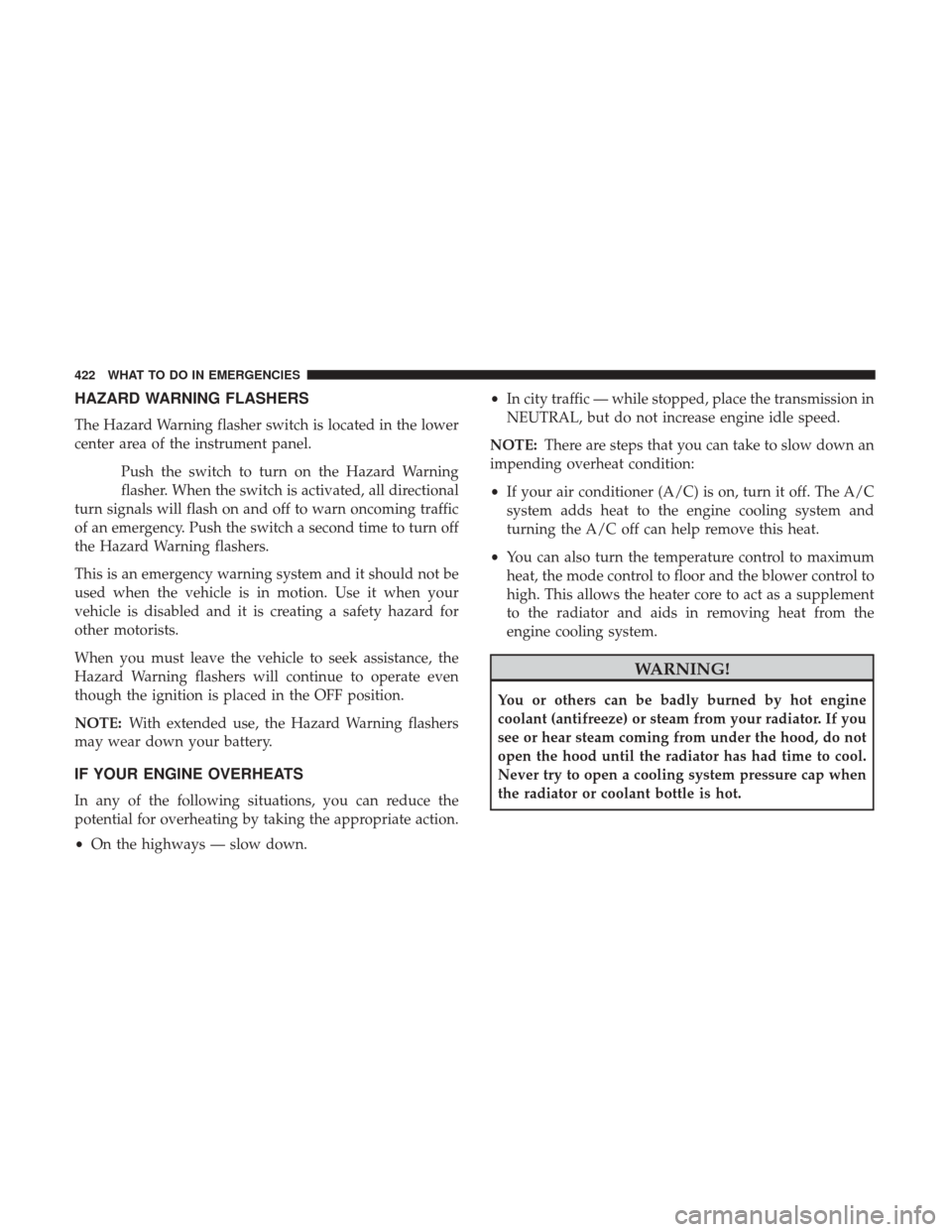
HAZARD WARNING FLASHERS
The Hazard Warning flasher switch is located in the lower
center area of the instrument panel.Push the switch to turn on the Hazard Warning
flasher. When the switch is activated, all directional
turn signals will flash on and off to warn oncoming traffic
of an emergency. Push the switch a second time to turn off
the Hazard Warning flashers.
This is an emergency warning system and it should not be
used when the vehicle is in motion. Use it when your
vehicle is disabled and it is creating a safety hazard for
other motorists.
When you must leave the vehicle to seek assistance, the
Hazard Warning flashers will continue to operate even
though the ignition is placed in the OFF position.
NOTE: With extended use, the Hazard Warning flashers
may wear down your battery.
IF YOUR ENGINE OVERHEATS
In any of the following situations, you can reduce the
potential for overheating by taking the appropriate action.
• On the highways — slow down. •
In city traffic — while stopped, place the transmission in
NEUTRAL, but do not increase engine idle speed.
NOTE: There are steps that you can take to slow down an
impending overheat condition:
• If your air conditioner (A/C) is on, turn it off. The A/C
system adds heat to the engine cooling system and
turning the A/C off can help remove this heat.
• You can also turn the temperature control to maximum
heat, the mode control to floor and the blower control to
high. This allows the heater core to act as a supplement
to the radiator and aids in removing heat from the
engine cooling system.
WARNING!
You or others can be badly burned by hot engine
coolant (antifreeze) or steam from your radiator. If you
see or hear steam coming from under the hood, do not
open the hood until the radiator has had time to cool.
Never try to open a cooling system pressure cap when
the radiator or coolant bottle is hot.
422 WHAT TO DO IN EMERGENCIES
Page 474 of 530
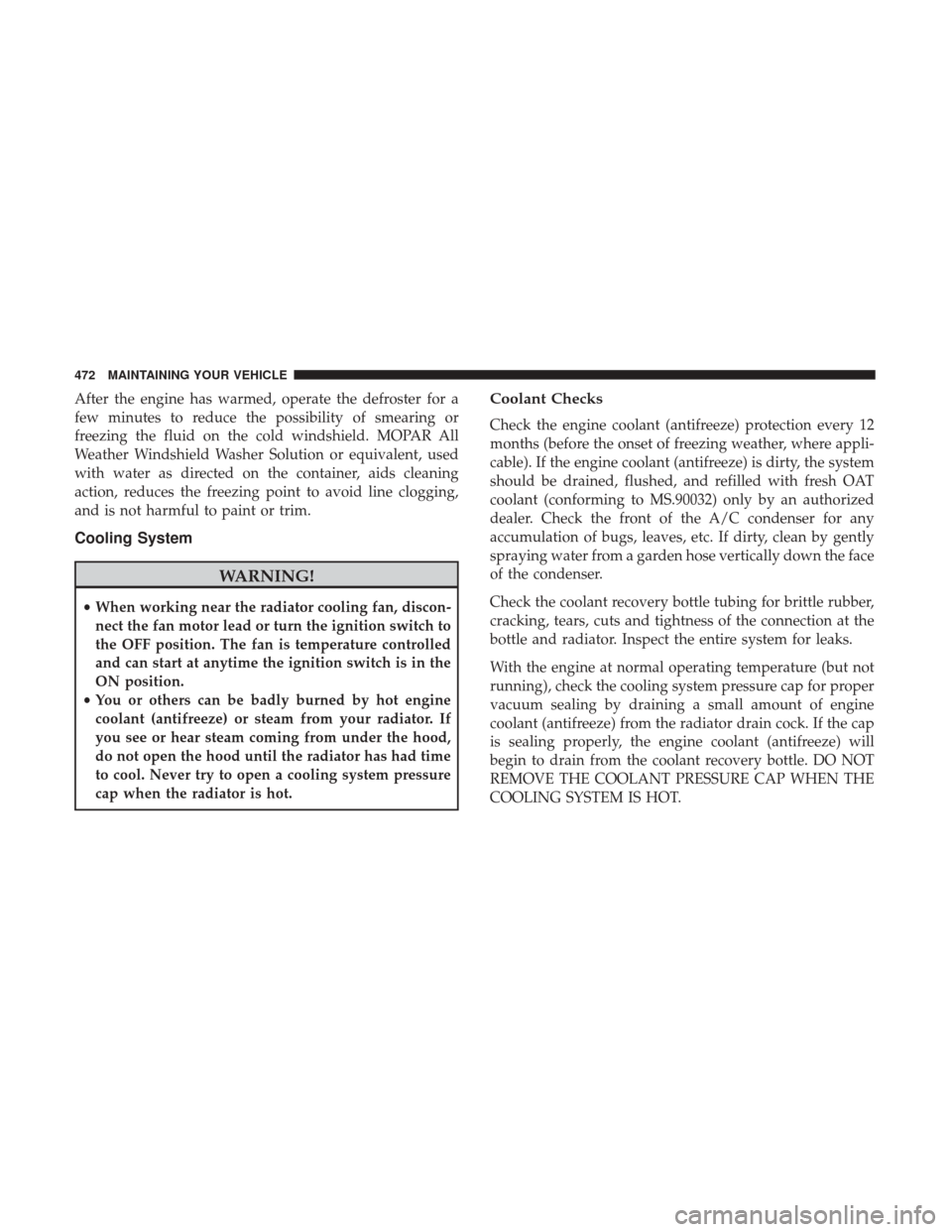
After the engine has warmed, operate the defroster for a
few minutes to reduce the possibility of smearing or
freezing the fluid on the cold windshield. MOPAR All
Weather Windshield Washer Solution or equivalent, used
with water as directed on the container, aids cleaning
action, reduces the freezing point to avoid line clogging,
and is not harmful to paint or trim.
Cooling System
WARNING!
•When working near the radiator cooling fan, discon-
nect the fan motor lead or turn the ignition switch to
the OFF position. The fan is temperature controlled
and can start at anytime the ignition switch is in the
ON position.
• You or others can be badly burned by hot engine
coolant (antifreeze) or steam from your radiator. If
you see or hear steam coming from under the hood,
do not open the hood until the radiator has had time
to cool. Never try to open a cooling system pressure
cap when the radiator is hot.
Coolant Checks
Check the engine coolant (antifreeze) protection every 12
months (before the onset of freezing weather, where appli-
cable). If the engine coolant (antifreeze) is dirty, the system
should be drained, flushed, and refilled with fresh OAT
coolant (conforming to MS.90032) only by an authorized
dealer. Check the front of the A/C condenser for any
accumulation of bugs, leaves, etc. If dirty, clean by gently
spraying water from a garden hose vertically down the face
of the condenser.
Check the coolant recovery bottle tubing for brittle rubber,
cracking, tears, cuts and tightness of the connection at the
bottle and radiator. Inspect the entire system for leaks.
With the engine at normal operating temperature (but not
running), check the cooling system pressure cap for proper
vacuum sealing by draining a small amount of engine
coolant (antifreeze) from the radiator drain cock. If the cap
is sealing properly, the engine coolant (antifreeze) will
begin to drain from the coolant recovery bottle. DO NOT
REMOVE THE COOLANT PRESSURE CAP WHEN THE
COOLING SYSTEM IS HOT.
472 MAINTAINING YOUR VEHICLE
Page 477 of 530
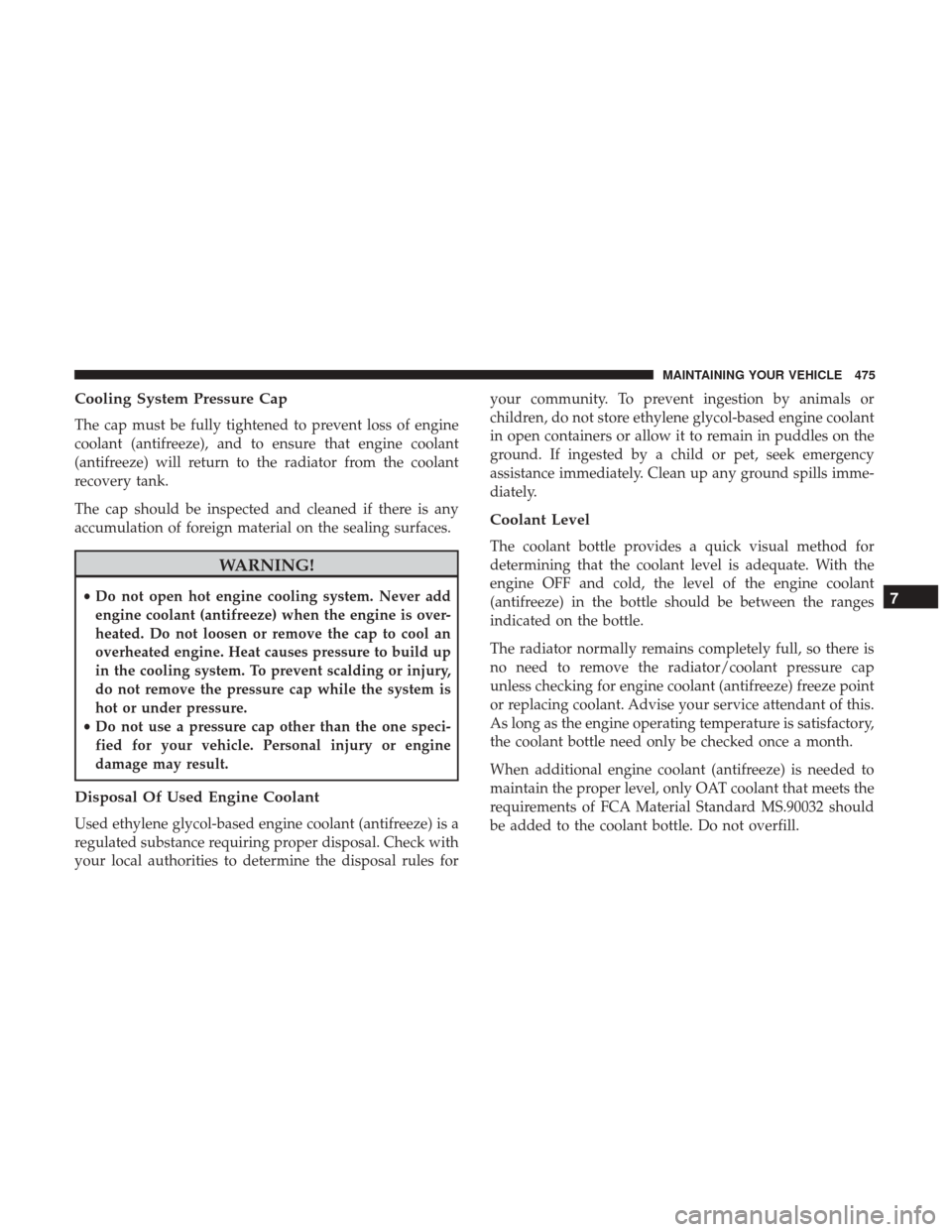
Cooling System Pressure Cap
The cap must be fully tightened to prevent loss of engine
coolant (antifreeze), and to ensure that engine coolant
(antifreeze) will return to the radiator from the coolant
recovery tank.
The cap should be inspected and cleaned if there is any
accumulation of foreign material on the sealing surfaces.
WARNING!
•Do not open hot engine cooling system. Never add
engine coolant (antifreeze) when the engine is over-
heated. Do not loosen or remove the cap to cool an
overheated engine. Heat causes pressure to build up
in the cooling system. To prevent scalding or injury,
do not remove the pressure cap while the system is
hot or under pressure.
• Do not use a pressure cap other than the one speci-
fied for your vehicle. Personal injury or engine
damage may result.
Disposal Of Used Engine Coolant
Used ethylene glycol-based engine coolant (antifreeze) is a
regulated substance requiring proper disposal. Check with
your local authorities to determine the disposal rules for your community. To prevent ingestion by animals or
children, do not store ethylene glycol-based engine coolant
in open containers or allow it to remain in puddles on the
ground. If ingested by a child or pet, seek emergency
assistance immediately. Clean up any ground spills imme-
diately.
Coolant Level
The coolant bottle provides a quick visual method for
determining that the coolant level is adequate. With the
engine OFF and cold, the level of the engine coolant
(antifreeze) in the bottle should be between the ranges
indicated on the bottle.
The radiator normally remains completely full, so there is
no need to remove the radiator/coolant pressure cap
unless checking for engine coolant (antifreeze) freeze point
or replacing coolant. Advise your service attendant of this.
As long as the engine operating temperature is satisfactory,
the coolant bottle need only be checked once a month.
When additional engine coolant (antifreeze) is needed to
maintain the proper level, only OAT coolant that meets the
requirements of FCA Material Standard MS.90032 should
be added to the coolant bottle. Do not overfill.
7
MAINTAINING YOUR VEHICLE 475
Page 515 of 530

Fluid And Filter Changes...................479
Fluid Change .......................... .479
Fluid Level Check ........................479
Fluid Type ..........................478, 498
Gear Ranges ............................348
Special Additives ........................ .478
Torque Converter ........................353
Auto Up Power Windows .....................31
Battery ...............................244, 468
Charging System Light ....................244
Jump Starting .......................... .448
Keyless Key Fob Replacement ................21
Saving Feature (Protection) ..................177
Belts, Seat .................................93
Body Mechanism Lubrication ..................470
B-Pillar Location .......................... .374
Brake Assist System ........................ .361
Brake Control System, Electronic ................359
Brake Fluid ...............................498
Brake System ..........................359, 476
Anti-Lock (ABS) ........................ .359
Fluid Check ............................477
Parking ...............................357
Warning Light .......................... .243Brake/Transmission Interlock
..................346
Bulb Replacement ..........................492
Bulbs, Light ............................95, 491
Calibration, Compass ........................267
Camera, Rear ............................ .192
Capacities, Fluid .......................... .495
Caps, Filler Fuel ................................. .404
Power Steering ..........................356
Radiator (Coolant Pressure) .................475
Carbon Monoxide Warning .................93, 402
Cargo Compartment Luggage Carrier ........................ .225
Car go
(Vehicle Loading) ..................... .219
Car Washes ...............................480
Center High Mounted Stop Light ...............494
Certification Label ..........................406
Chains, Tire ............................. .388
Changing A Flat Tire ........................433
Chart, Tire Sizing .......................... .370
Check Engine Light (Malfunction Indicator Light). . . .461
Checking Your Vehicle For Safety ................92
Checks, Safety .............................92
Child Restraint .............................71
10
INDEX 513
Page 516 of 530
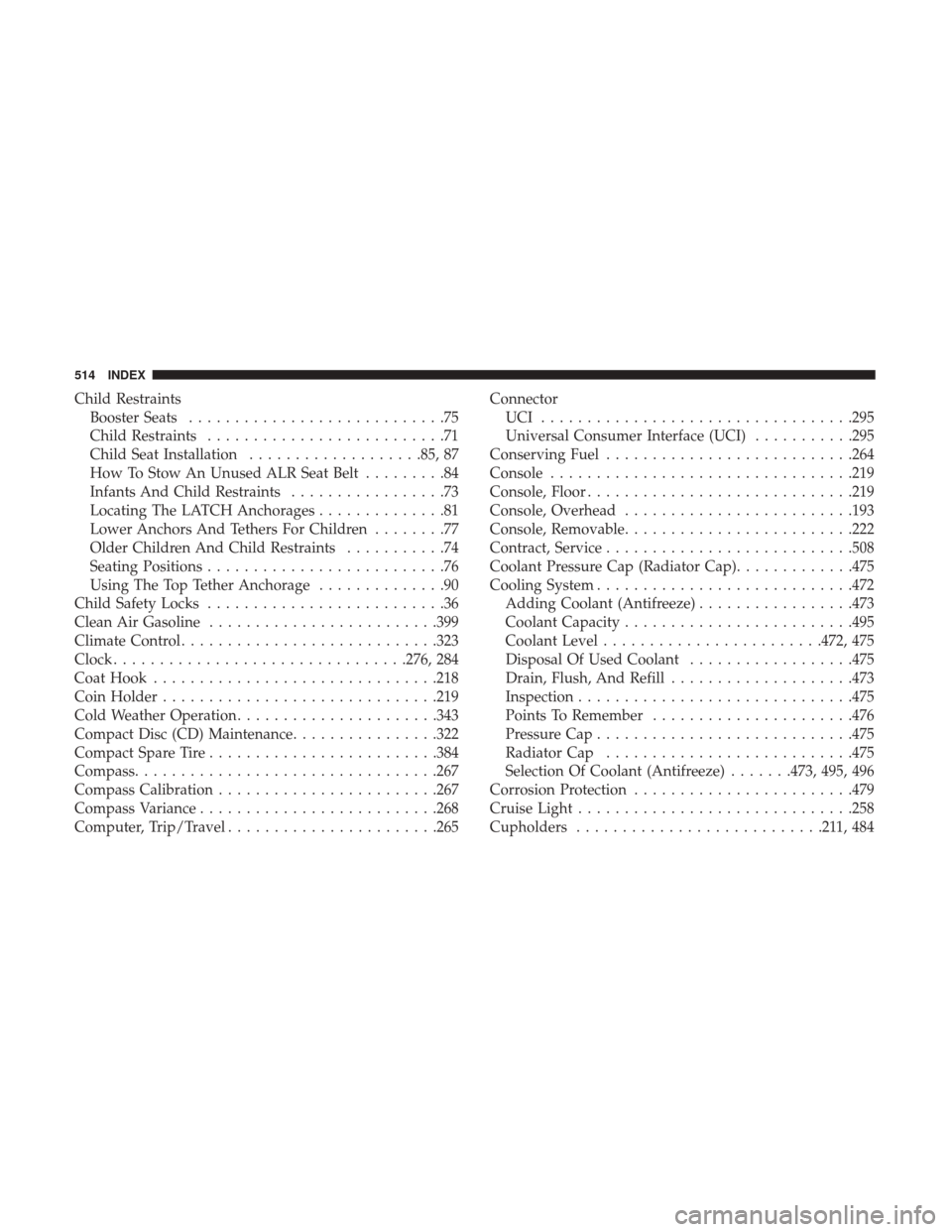
Child RestraintsBooster Seats ............................75
Child Restraints ..........................71
Child Seat Installation ...................85, 87
How To Stow An Unused ALR Seat Belt .........84
Infants And Child Restraints .................73
Locating The LATCH Anchorages ..............81
Lower Anchors And Tethers For Children ........77
Older Children And Child Restraints ...........74
Seating Positions ..........................76
Using The Top Tether Anchorage ..............90
Child Safety Locks ..........................36
Clean Air Gasoline ........................ .399
Climate Control ............................323
Clock ............................... .276, 284
Coat Hook ...............................218
Coin Holder ............................. .219
Cold Weather Operation ..................... .343
Compact Disc (CD) Maintenance ................322
Compact Spare Tire ........................ .384
Compass .................................267
Compass Calibration ........................267
Compass Variance ..........................268
Computer, Trip/Travel .......................265 Connector
UCI ..................................295
Universal Consumer Interface (UCI) ...........295
Conserving Fuel .......................... .264
Console .................................219
Console, Floor ............................ .219
Console, Overhead ........................ .193
Console, Removable ........................ .222
Contract, Service .......................... .508
Coolant Pressure Cap (Radiator Cap) .............475
Cooling System ............................472
Adding Coolant (Antifreeze) .................473
Coolant Capacity ........................ .495
Coolant Level ........................472, 475
Disposal Of Used Coolant ..................475
Drain, Flush,
And Refill ....................473
Inspection ............................. .475
Points To Remember ..................... .476
Pressure Cap ............................475
Radiator Cap .......................... .475
Selection Of Coolant (Antifreeze) .......473, 495, 496
Corrosion Protection ........................479
Cruise Light ............................. .258
Cupholders ...........................211,484
514 INDEX
Page 523 of 530
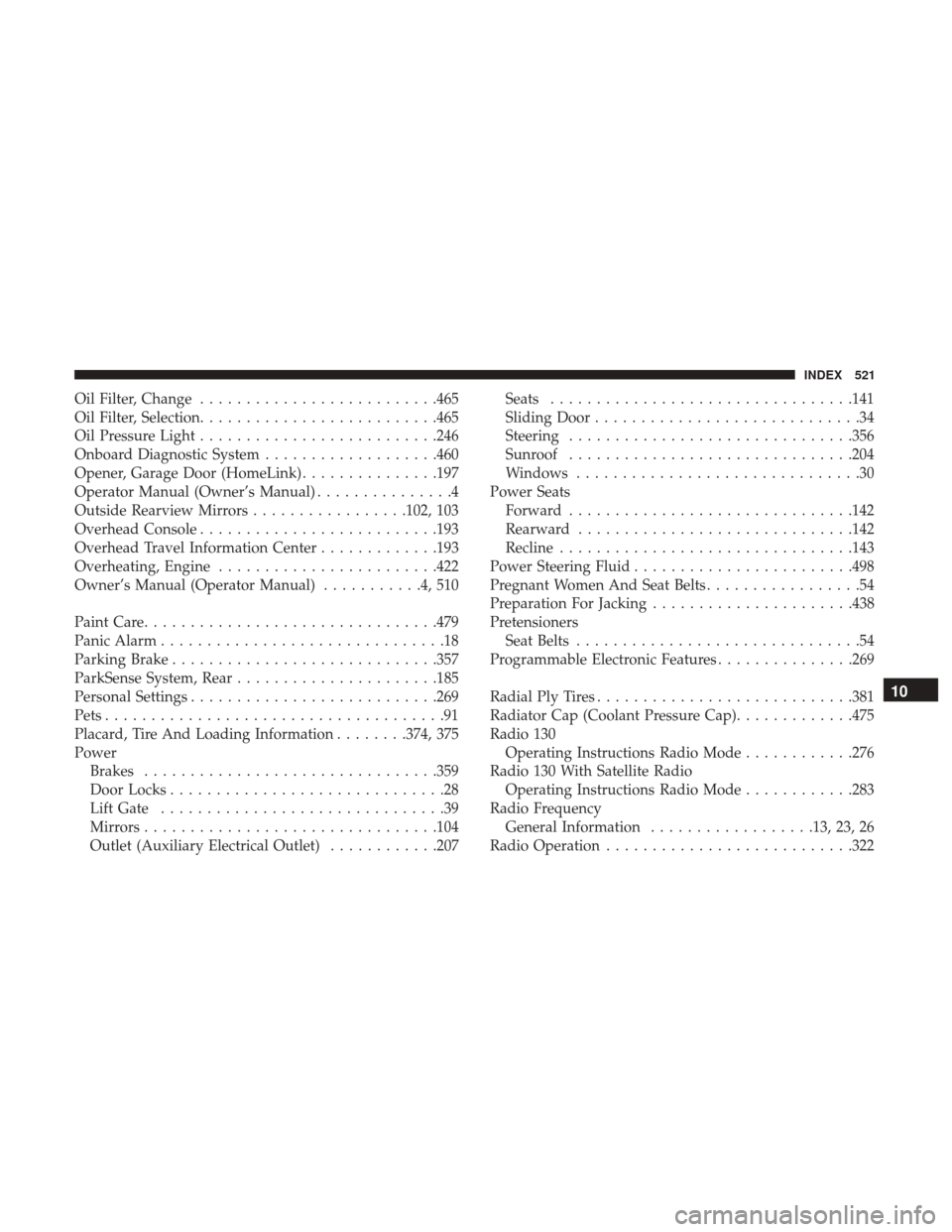
Oil Filter, Change..........................465
Oil Filter, Selection ..........................465
Oil Pressure Light ..........................246
Onboard Diagnostic System ...................460
Opener, Garage Door (HomeLink) ...............197
Operator Manual (Owner’s Manual) ...............4
Outside Rearview Mirrors .................102, 103
Overhead Console ..........................193
Overhead Travel Information Center .............193
Overheating, Engine ........................422
Owner’s Manual (Operator Manual) ...........4,510
Paint Care ............................... .479
Panic Alarm ...............................18
Parking Brake ............................ .357
ParkSense System, Rear ..................... .185
Personal Settings .......................... .269
Pets .....................................91
Placard, Tire And Loading Information ........374, 375
Power Brakes ............................... .359
Door Locks ..............................28
Lift Gate ...............................39
Mirrors ............................... .104
Outlet (Auxiliary Electrical Outlet) ............207Seats
.................................141
Sliding Door .............................34
Steering ...............................356
Sunroof ...............................204
Windows ...............................30
Power Seats Forward ...............................142
Rearward ............................. .142
Recline ............................... .143
Power Steering Fluid ........................498
Pregnant Women And Seat Belts .................54
Preparation For Jacking ..................... .438
Pretensioners Seat Belts ...............................54
Programmable Electronic Features ...............269
Radial Ply Tires ............................381
Radiator Cap
(Coolant Pressure Cap) .............475
Radio 130 Operating Instructions Radio Mode ............276
Radio 130 With Satellite Radio Operating Instructions Radio Mode ............283
Radio Frequency General Information ..................13, 23, 26
Radio Operation .......................... .32210
INDEX 521